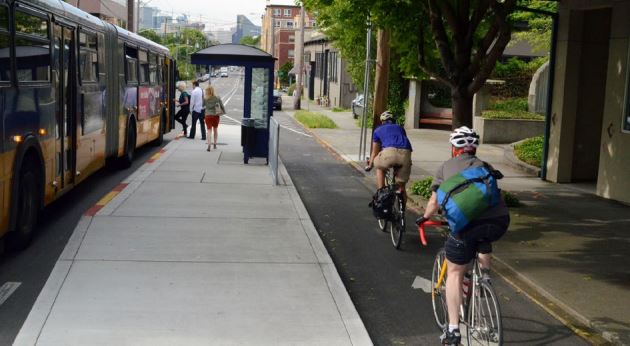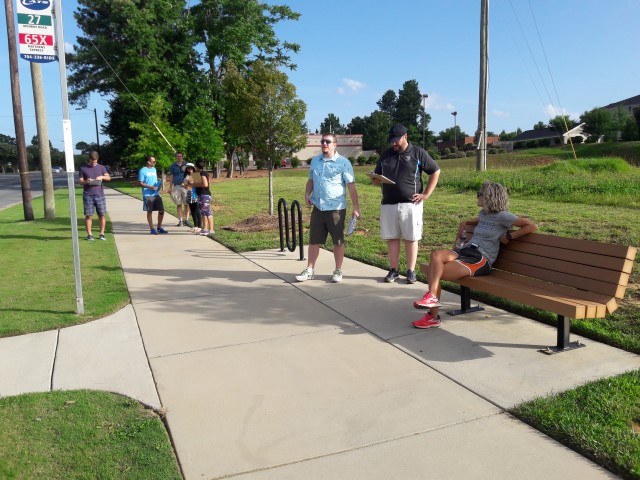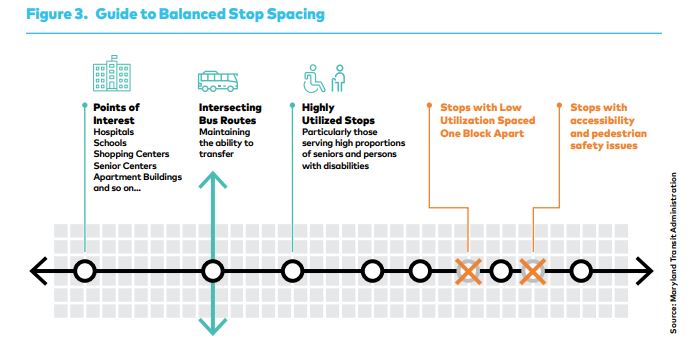What makes a bus stop great?
Now that the CATS bus network has been redesigned through the Envision My Ride initiative, there are still two major areas where the experience for riders can still be improved. The first of these is more frequent service, which will require additional funding to pay for more drivers. The second is better conditions for riders as they walk to and wait at bus stops.
In today’s blog post, we explore the importance of great bus stop design and balanced bus stop spacing as covered inTransitCenter’s new From Sorry to Superb: Everything You Need To Know About Great Bus Stops report.

Great bus stops provide a safe and comfortable waiting experience for riders. (image: Sorry to Superb report)
Check out the full Sorry to Superb report here! In an upcoming blog post, we’ll dig deeper into the report to highlight case studies of how different transit agencies manage bus stops and set goals for improving them.
At a basic level, what makes a bus stop comfortable, safe, and inviting?
It’s pretty simple. It should be safe for riders to walk to the bus stop, since most people access bus stops on foot. Once they reach the stop, there should be a comfortable, safe, and well-lighted place to wait. The stop should be matched to the vehicle serving it so that riders have a seamless experience getting from the stop onto the bus (especially for those using wheelchairs or strollers), and vice-versa. The less often buses have to pull out of a traffic lane to reach stops, the faster the bus can move along its route. Lighting, seating, trash cans, and clear signage contribute to a better rider experience..

Walk2Transit volunteers loved this new CATS bus stop on Monroe Road!
Not every stop needs a full shelter. Some stops are on easements located in residential front yards where a full shelter may not be appropriate. Stops towards the end of a route that mostly serve outbound riders may not need many amenities for waiting because most of the riders using that stop will walk to their final destination right after they disembark.
Transit agencies should analyze ridership data to determine where stops are most needed. They should also analyze pedestrian injury data alongside the local department of transportation to determine where more infrastructure is needed to help people reach the bus stop area safely.
How far apart should bus stops be?
In walkable neighborhoods, TransitCenter recommends spacing bus stops 1/4 to 1/2 mile apart. This does two things: It allows the bus to move quickly and reliably, and it allows the transit agency to invest in fewer, but higher quality bus stop amenities. Less walkable neighborhoods or those with high proportions or seniors and persons with disabilities will need bus stops spaced closer together.

There are many considerations in determining bus stop spacing (image: Sorry to Superb report)
Following CATS’ bus network redesign on October 1st, it’s become apparent that some changes to bus stop spacing may be needed to keep running buses on time. Some of the routes with higher ridership now have many more riders boarding and disembarking at stops that were sparsely used in the past. When the bus has to stop at nearly every stop, it can begin to run behind schedule. That’s particularly problematic during morning and afternoon rush hours.
We know that CATS is evaluating the new ridership patterns. They plan to adjust bus stop amenities to reflect shifts in ridership and needs of customers. By incorporating best practices for bus stop spacing, CATS can work towards its goal of providing faster and more reliable service throughout the transit network.
Join us for the next blog post where we’ll examine how other cities manage their bus stops, and what Charlotte could learn from their successes and missteps.
Sustain Charlotte’s work to advocate for a better bus network is funded by TransitCenter.
Thanks for reading!
As a nonprofit, community support is essential for us to keep doing what we do — including providing free articles like this. If you found this article helpful, please consider supporting Sustain Charlotte.
Want to stay in the loop? Subscribe to our weekly newsletter and follow us on Instagram, Facebook, and Twitter.
